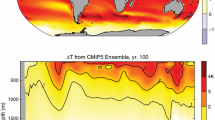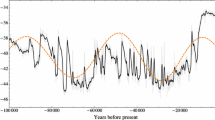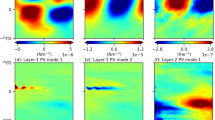Abstract
We examine the equilibrated and time-evolving adjoint solutions of an ocean general circulation model. Adjoint models calculate the sensitivity of a diagnostic, (here, the strength of the meridional overturning) to all forcing fields in a single integration. The time evolution of the sensitivity patterns demonstrates the validity of the adjoint modeling approach over climatological time scales in coarse-resolution ocean models. Our objective is to identify the principle adjustment mechanisms through which the meridional overturning strength adapts to perturbations in wind and buoyancy forcing. The adjoint approach is shown to be a valuable alternative to traditional perturbation methods in highlighting the processes and time scales important to ocean and climate modeling.





Similar content being viewed by others
References
Bryan K (1984) Accelerating the convergence to equilibrium of ocean-climate models. J Phys Oceanogr 14:666–673
Colin De Verdière A (1988) Buoyancy driven planetary flows. J Mar Res 46:215–265
Danabasoglu G (2004) A comparison of global ocean circulation model solutions obtained with synchronous and accelerated integration methods. Ocean Model 7:323–341
Danabasoglu G, McWilliams JC (1995) Sensitivity of the global ocean circulation to parameterizations of mesoscale tracer transports. J Climate 8:2967–2987
Danabasoglu G, McWilliams J, Large WG (1996) Approach to equilibrium in accelerated global oceanic models. J. Climate 9:1092–1110
Galanti E, Tziperman E (2003) A midlatitude-enso teleconnection mechanism via baroclinically unstable long Rossby waves. J Phys Oceanogr 33:1877–1888
Gent P, McWilliams J (1990) Isopycnal mixing in ocean circulation models. J Phys Oceanogr 20:150–155
Gill AE (1982) Atmosphere–ocean dynamics. International geophysics series, vol 31. Academic, New York
Griewank A, Corliss G (eds) (1991) Automatic differentiation of algorithms: theory, implementation and application. SIAM, Philadelphia
Hall MCG, Cacuci DG, Schlesinger ME (1982) Sensitivity analysis of a radiative–convective model by the adjoint method. J Atmos Sci 39:2038–2050
Heimbach P, Hill C, Giering R (2002) Automatic generation of efficient adjoint code for a parallel Navier–Stokes solver. In: Dongarra J, Sloot P, Tan C (eds) ICCS 2002: proceedings of the international conference on computer science and its application. Lecture notes in computer science, vol 2330. Springer, Berlin Heidelberg New York, pp 1019–1028
Huang R, Pedlosky J (2002) On aliasing Rossby waves induced by asynchronous time stepping. Ocean Model 5:65–76
Huang RX, Cane MA, Naik N, Goodman P (2000) Global adjustment of the thermocline in response to deepwater formation. Geophys Res Lett 27(6):759–762
Jiang S, Stone P, Malanotte-Rizzoli P (1999) An assessment of the GFDL ocean model with coarse resolution: annual-mean climatology. J Geophys Res 104(C11):25623–25645
Johnson E, McPhaden M (1993) Structure of intraseasonal Kelvin waves in the equatorial Pacific Ocean. J Phys Oceanogr 23:608–625
Kawase M (1987) Establishment of deep ocean circulation driven by deep-water production. J Phys Oceanogr 17:2294–2311
Lanczos C (1961) Linear differential operators. Van Nostrand, New York
Lea DJ, Allen MR, Haine TWN (2000) Sensitivity analysis of the climate of a chaotic system. Tellus 52A:523–532
Marotzke J, Scott J (1999) Convective mixing and the thermohaline circulation. J Phys Oceanogr 29:2962–2970
Marotzke J, Giering R, Zhang KQ, Stammer D, Hill C, Lee T (1999) Construction of the adjoint MIT ocean general circulation model and application to Atlantic heat transport sensitivity. J Geophys Res 104(29):529–547
Marshall J, Adcroft A, Hill C, Perelman L, Heisey C (1997a) Hydrostatic, quasi-hydrostatic and nonhydrostatic ocean modeling. J Geophys Res 102(C3):5, 5753–5766
Marshall J, Hill C, Perelman L, Adcroft A (1997b) Hydrostatic, quasi-hydrostatic and nonhydrostatic ocean modeling. J Geophys Res 102(C3):5, 5733–5752
McDermott DA (1996) The regulation of northern overturning by southern hemisphere winds. J Phys Oceanogr 26:1234–1255
Morse PM, Feshbach H (1953) Methods of theoretical physics. McGraw-Hill, New York
Redi M (1982) Oceanic isopycnal mixing by coordinate rotation. J Phys Oceanogr 12:1154–1158
Schmitt R, Bogden P, Dorman CE (1989) Evaporation minus precipitation and density fluxes for the north Atlantic. J Phys Oceanogr 19:1208–1221
Sirkes Z, Tziperman E (1997) Finite difference of adjoint or adjoint of finite difference? Mon Weather Rev 125:3373–3378
Trenberth K, Solomon A (1994) The global heat balance: heat transport in the atmosphere and ocean. Clim Dyn 10:107–134
Trenberth KE, Olson JG, Large WG (1989) A global ocean wind stress climatology based on ECMWF analysis. Technical report NCAR/TN-338+STR. NCAR, Boulder
van Oldenborgh G, Burgers G, Venzke S, Eckert C, Giering R (1999) Tracking down the ENSO delayed oscillator with an adjoint OGCM. Mon Weather Rev 127:1477–1496
We wish to thank Peter Stone for his scientific support of this work and for his role as thesis supervisor for this project. The research presented here was partially supported with funds from the US Department of Energy. We are indebted to two anonymous reviewers for their constructive comments.
Author information
Authors and Affiliations
Corresponding author
Additional information
Responsible Editor: Richard Signell
Rights and permissions
About this article
Cite this article
Bugnion, V., Hill, C. Equilibration mechanisms in an adjoint ocean general circulation model. Ocean Dynamics 56, 51–61 (2006). https://doi.org/10.1007/s10236-005-0052-z
Received:
Accepted:
Published:
Issue Date:
DOI: https://doi.org/10.1007/s10236-005-0052-z




